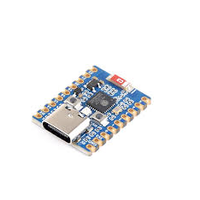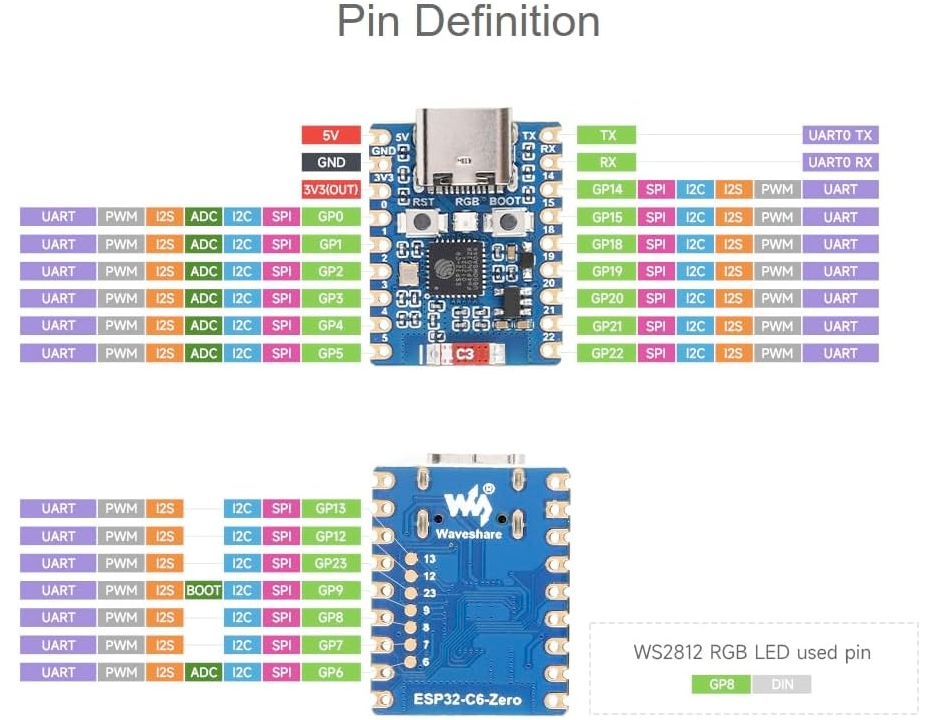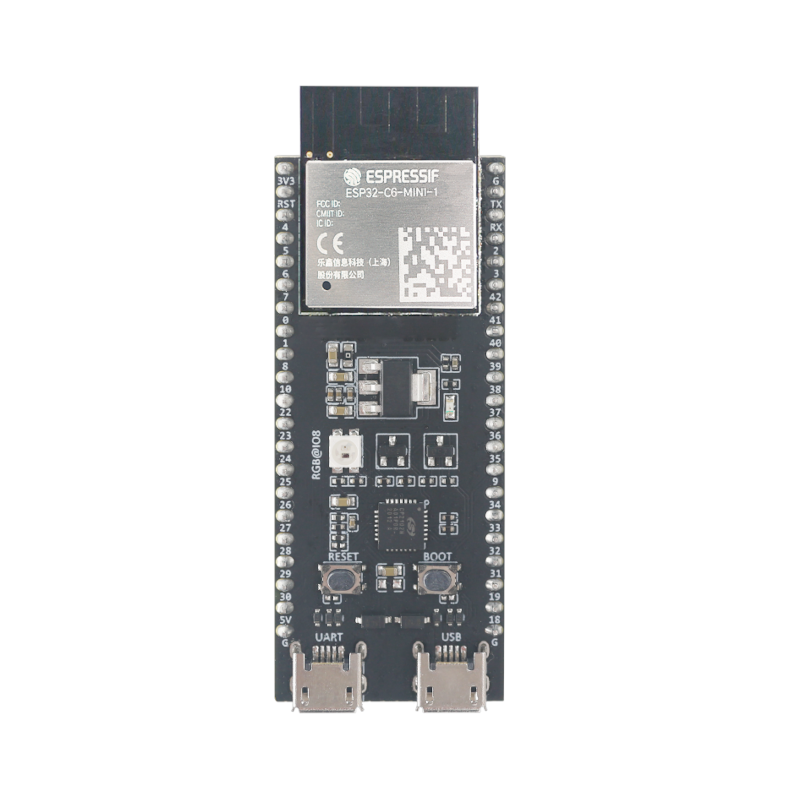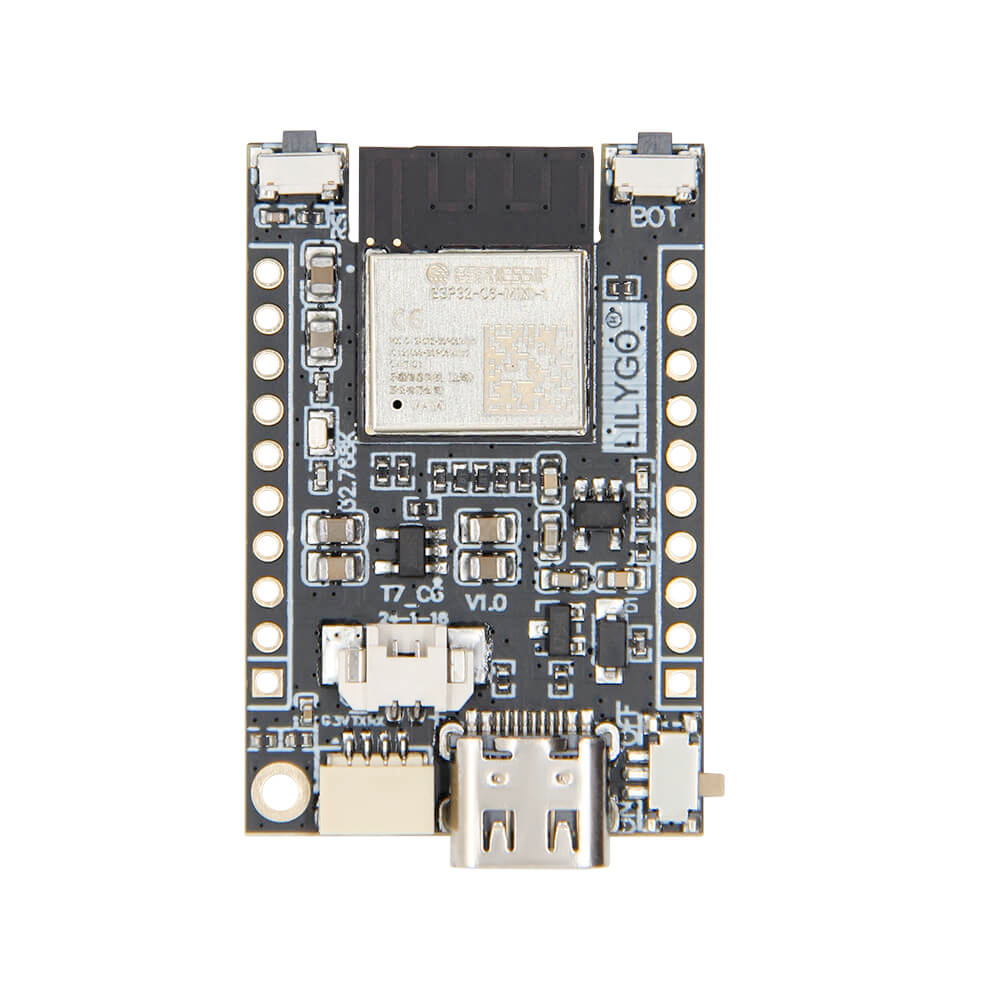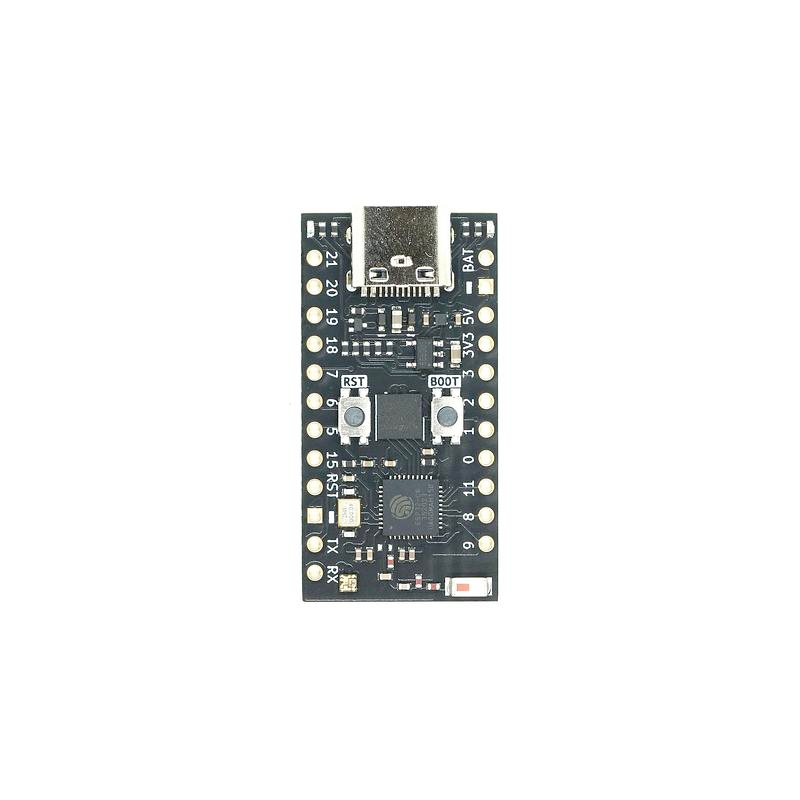ESP32 C6 Zero Mini Development Board
Code name: TINYC6
ESP32 C6 Zero Mini development board is based on esp32c6 microcontroller and uses riscv32 architecture. This board has a maximum CPU frequency of 160 MHz and a flash size of 4MB.
About ESP32 C6 Zero Mini
Minimal ESP32-C6 board with RISC-V and modern wireless - ideal for cost-sensitive, compact Matter-based builds.
Where to Buy



Prices are subject to change. We earn from qualifying purchases as an Amazon Associate.
Technical Specifications
🛰️ Connectivity
🧠 Microcontroller
✨ Features
- ESP32-C6FH4: Built-in dual processors, main frequency is up to 160 MHz
- USB Type-C Port for downloading programme and debugging
- ME6217C33M5G low dropout LDO, 800mA (Max)
- WS2812 RGB LED
- 2.4G ceramic antenna
- BOOT button: Press it and then press the RESET button to enter download mode
- RESET button
- ESP32-C6FH4 pins
ESP32 C6 Zero Mini Pinout
✅ Safe Pins to Use
For general GPIO usage, these are the safest and most flexible choices:
Why Are These Pins Safe?
- Not involved in bootstrapping → No impact on device boot mode or system startup
- Not linked to flash memory or PSRAM → Won't interfere with storage or memory access
- Not dedicated to USB or JTAG → Free for general use without affecting debugging
- No special hardware connections → Freely assignable without internal conflicts
⚠️ Pins to Avoid or Use with Caution
Some pins are reserved for critical functions like bootstrapping, JTAG debugging, USB communication, and flash memory operations. Misusing these pins may lead to boot failures, programming issues, USB conflicts, or disruptions in flash storage.
Critical Pin Categories:
- 🛠️ Strapping Pins: Control boot behavior and flash voltage selection
- 🔗 JTAG Debugging Pins: Required for low-level debugging
- 🔌 USB Communication Pins: Used for USB Serial/JTAG communication
- ⚡ Flash Memory & SPI Pins: Connected to SPI flash memory and PSRAM
- 📡 UART Serial Communication Pins: Used for debugging and firmware uploads
| PIN | Label | Reason | Function |
|---|---|---|---|
| IO4 | MTMS | Used during boot; required for JTAG debugging; flash data in internal-flash models. | 🛠️ Strapping |
| IO5 | MTDI | Used during boot; required for JTAG debugging; flash data in internal-flash models. | 🛠️ Strapping |
| IO6 | MTCK | Required for JTAG debugging; connected to flash clock in internal-flash models. | 🔗 JTAG |
| IO7 | MTDO | Required for JTAG debugging; connected to flash data in internal-flash models. | 🔗 JTAG |
| IO8 | GPIO8 | Determines boot mode; pulling low at reset can prevent normal boot. | 🛠️ Strapping |
ESP32 C6 Zero Mini Pin Mappings
This development board provides digital IO pins, out of which can be used as external interrupt pins and as analog input pins .
| Pin | Function | ESP Pin | Input/Output | Description |
|---|---|---|---|---|
| 1 | 5V | 5V | POWER INPUT | 5V power input for the board |
| 2 | GND | GND | POWER GROUND | Ground connection |
| 3 | 3V3 | 3.3V | POWER OUTPUT | 3.3V power output for peripherals |
| 4 | TX | TX | TX | TX |
| 5 | RX | RX | RX | RX |
| 6 | IO0 | GP0 | BIDIRECTIONAL | GPIO, ADC pin |
| 7 | IO1 | GP1 | BIDIRECTIONAL | GPIO, ADC pin |
| 8 | IO2 | GP2 | BIDIRECTIONAL | GPIO, ADC pin |
| 9 | IO3 | GP3 | BIDIRECTIONAL | GPIO, ADC pin |
| 10 | IO4 | GP4 | BIDIRECTIONAL | GPIO, ADC pin |
| 11 | IO5 | GP5 | BIDIRECTIONAL | GPIO, ADC pin |
| 12 | IO6 | GP6 | BIDIRECTIONAL | GPIO, ADC pin |
| 13 | IO7 | GP7 | BIDIRECTIONAL | GPIO |
| 14 | IO8 | GP8 | BIDIRECTIONAL | GPIO, LED |
| 15 | IO9 | GP9 | BIDIRECTIONAL | GPIO, BOOT |
| 16 | IO12 | GP12 | BIDIRECTIONAL | GPIO |
| 17 | IO13 | GP13 | BIDIRECTIONAL | GPIO |
| 18 | IO14 | GP14 | BIDIRECTIONAL | GPIO |
| 19 | IO15 | GP15 | BIDIRECTIONAL | GPIO |
| 20 | IO18 | GP18 | BIDIRECTIONAL | GPIO |
| 21 | IO19 | GP19 | BIDIRECTIONAL | GPIO |
| 22 | IO20 | GP20 | BIDIRECTIONAL | GPIO |
| 23 | IO21 | GP21 | BIDIRECTIONAL | GPIO |
| 24 | IO22 | GP22 | BIDIRECTIONAL | GPIO |
| 25 | IO23 | GP23 | BIDIRECTIONAL | GPIO |
ESP32 C6 Zero Mini Pins Mapping Arduino IDE
Below you can find the ESP32 C6 Zero Mini pinout. This development board provides digital IO pins, out of which can be used as external interrupt pins and as analog input pins .
| Pin | Analog | Touch | PWM | Other |
|---|---|---|---|---|
| 1 | A0 | T1 | ||
| 2 | A1 | T2 | ||
| 3 | A2 | T3 | ||
| 4 | A3 | T4 | VBAT_SENSE | |
| 5 | A4 | T5 | ||
| 6 | A5 | T6 | SDA | |
| 7 | A6 | T7 | SCL | |
| 8 | A7 | T8 | ||
| 9 | A8 | T9 | ||
| 10 | VBUS_SENSE | |||
| 16 | TX | |||
| 17 | RX | |||
| 18 | SS | |||
| 19 | SCK | |||
| 20 | MISO SDI | |||
| 21 | MOSI SDO | |||
| 22 | RGB_PWR | |||
| 23 | RGB_DATA | |||
| RGB_BUILTIN | LED_BUILTIN |
Default Tools
| Bootloader tool | esptool_py |
| Uploader tool | esptool_py |
| Network uploader tool | esp_ota |
| Bootloader address | 0x0 |
| Flash mode | qio |
| Boot mode | qio |
| Maximum upload size | 1280 Kb (1310720 B) |
| Maximum data size | 320 Kb (327680 B) |
The ESP32 C6 Zero Mini development board by default uses esptool_py uploader tool, esp_ota network uploader tool for Over-the-air (OTA) uploads and esptool_py bootloader tool. The bootloader starts at address "0x0". Flash mode and boot mode for ESP32 C6 Zero Mini development board by default is qio and qio respectively.
